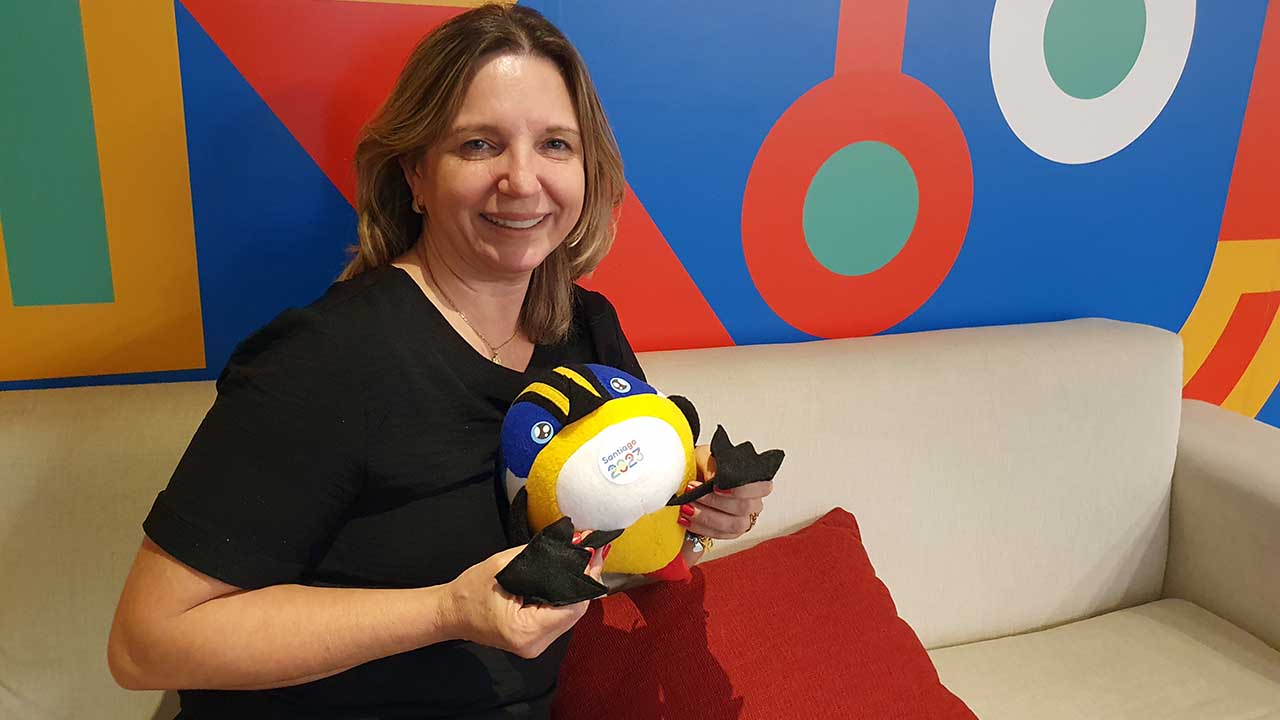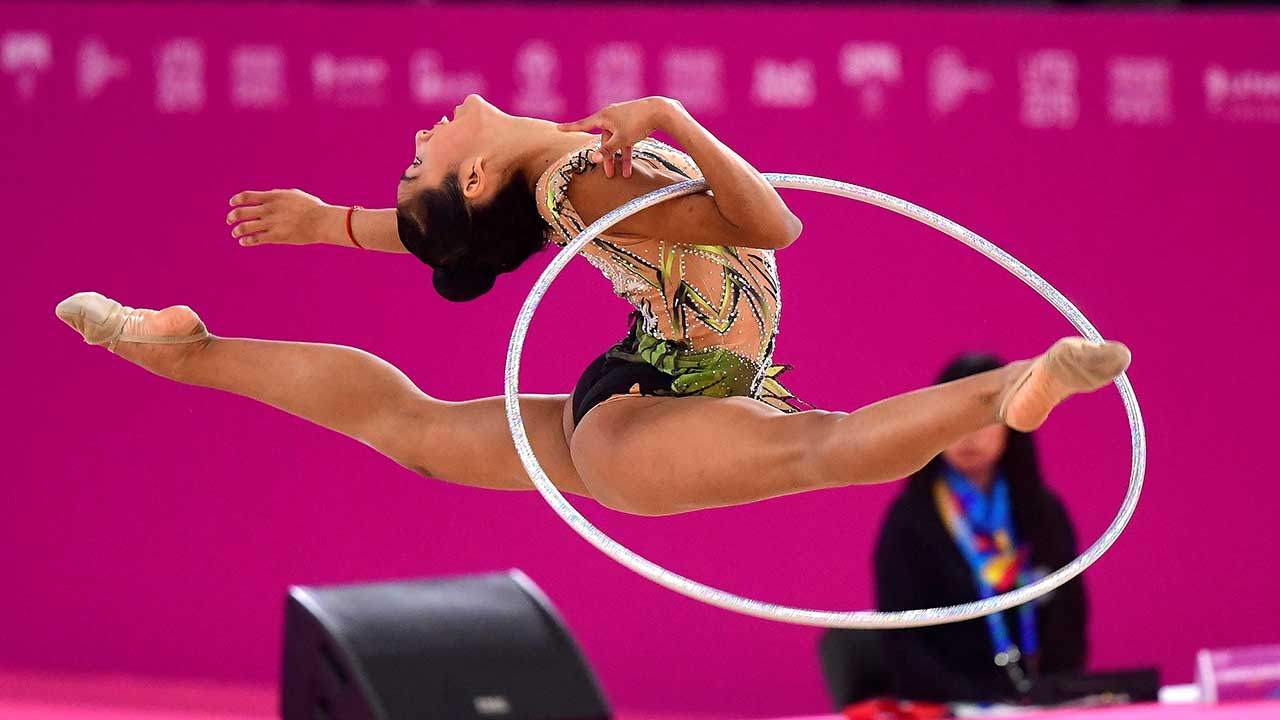The Brazilian Marcia Aversani, ex national athlete of her country, judge, and rhythmic gymnastics coach, visited Chile as an International Technical Delegate of this discipline. Also, she’s currently the President of the Technical Committee of the Pan American Gymnastics Union (PAGU) and member of the International Federation of Gymnastics (FIG).
She remembered her time as an athlete, “I participated in a tough competition called the Four Continents Championship. As rhythmic gymnastics was not developed around the world there were competitions in Europe, Asia, America, Africa, and Oceania. During 2003 it ended because gymnastics were more spread around the world,” she indicated.
As an executive she referred to the work with her counterparts from the Organizing Committee and valued the dedication to take care of each detail of this female competition. “We’ve been preparing for years, two years ago I started working at the UPAG and I’m sure this will be a great competition,” she expressed.
 The Brazilian Marcia Aversani visited Santiago 2023 to know all the rhythmic gymnastics details (picture from: Santiago 2023/ Germán Toro).
The Brazilian Marcia Aversani visited Santiago 2023 to know all the rhythmic gymnastics details (picture from: Santiago 2023/ Germán Toro).
VENUE: EL CENTRO DE DEPORTES COLECTIVOS OF PARQUE ESTADIO NACIONAL
Aversani saw the plan drawings and went to see the developments related to the building at the Centro de Deportes Colectivos, located inside the Parque Estadio Nacional. “It’s a very interesting precinct, great for gymnastics and it will host artistics, rhythmic, and trampoline. It adapts to the Pan American Games, it has a lot of space, good height, it’s beautiful and I do consider we will have all we could need,” she said.
HOW WILL BE THE QUALIFICATION FOR SANTIAGO 2023?
The ITD informed that the quotas for the Pan American Games will be provided specifically in the Pan American, which will be developed at the beginning of June in Guadalajara, Mexico. “In Chile we’ll have six countries that will be with two individual athletes, five of them with an individual athlete, and the champion of the Cali 2021 Junior Pan American Games, the Brazilian María Eduarda Alexandre,” she detailed.
“In addition, we’ll have seven teams, so this will be the biggest competition of the discipline during the history of the Pan American Games. This is a tendency because the American continent is currently very good, it’s possible to mention that there are three of the best teams around the world: Brazil, Mexico, and USA,” she added.
OLYMPIC QUALIFICATION: DIRECT QUOTAS FOR 2024
The Pan American Games will provide a direct quota, in both individual and teams, for Paris 2024. The winners of those quotas, mainly in collective competitions, will depend on what the continental delegations can do during the Rhythmic Gymnastics World Championships that will be developed between August 21st and 27th in Valencia, Spain.
“In Spain there will be five different teams that can qualify for Paris 2024, last year in the World Championship carried out in Bulgaria three people qualified, and now there will be five. We have Brazil in fifth place and Mexico in sixth place. So, we want the athletes to remain firm and achieve their qualification so Santiago 2023 could be the opportunity to have one more quota and having, in the teams competition, three countries of the Americas in the Olympic Games,” she indicated.
CHILE AS HOST AND ITS OPTIONS: “IT WILL BE COMPETING FOR A MEDAL”
The most recent precedent of Team Chile in this discipline shows a promising future: bronze in the teams category during the Asunción 2022 South American Games. The delegation was composed by Valentina Cuello, Martina Valdés, Isabel Lozano, Josefina Romero, Anneli Sepúlveda, Javiera Rubilar, and Martina Ferrari. “Chile is a country with a very nice rhythmic gymnastics history, it has an outstanding teams competition and I do consider they will be fighting hard for the medal,” she commented.
 The Chilean Javiera Rubilar was present at Lima 2019 and Asunción 2022 (picture from: Comunicaciones COCH).
The Chilean Javiera Rubilar was present at Lima 2019 and Asunción 2022 (picture from: Comunicaciones COCH).
RHYTHMIC GYMNASTICS, AN EASY EXPLANATION: THE GLOSSARY ACCORDING TO THE ITD
Definition: “it’s a plastic modality with a lot of esthetic beauty and evolving music that tells you a story. Gymnastics is a modality to watch with the family; for example, football is usually watched by men, but gymnastics is for parents and children.”
Ring: “In Brazil it is called Bambolé for children and in Chile hulahula. Boys and girls will see that it is possible to do amazing things with this object so familiar to them.”
Ball: “This can be used not just to score goals, but also it’s possible to do interesting things such as rolling it through the body, throwing it, passing it under the legs, and capturing it. It’s very interesting because the object is like a part of the body.”
Maces: “they are like a bottle and athletes do malabarism. Those are a lot of interesting movements and athletes must have great coordination on both sides of the body and be allowed to develop the same technique with the right and left side.”
Ribbon: “it’s the most beautiful and the one that everyone loves. The movements are big and they do differentiated draws such as: snakes, spirals, and boomerang throws. It’s a difficult object, maybe the hardest one but no doubt it’s the most beautiful.”
Five rings: “Five athletes at the same time on floorboards of 13x13 meters and each with a ring. Sometimes an athlete can have two or three rings and do throwings. There are also collaborations, that is when the athlete throws a ring, passes through another, does spins, and then recovers. It’s very plastic.”
Three ribbons / two balls: “it’s totally different than five rings. The athletes have to do the same movements at the same time and with different elements. The creativity and technique of the coach and athlete must be very well synchronized to develop a beautiful choreography.”
ALL ABOUT RHYTHMIC GYMNASTICS IN SANTIAGO 2023
Venue: Centro de Deportes Colectivos of Estadio Nacional.
Dates: Wednesday, November 1st to Saturday, November 4th.
Individual Female Competitions (5): general individual (all around), ring, ball, maces, and ribbon.
Teams Female Competitions (3): general teams (all around), five rings, and three ribbons/ two balls.
Participant countries: individual and seven teams.
Athletes quotas: 53 divided in 18 individuals + 35 teams (seven teams with 5 athletes each).
Maximum quota per country: seven athletes.
Minimum age: 16 years old.
Olympic qualification for Paris 2024: direct, one for individuals and one for teams.
ALL THE GOLD MEDALS IN LIMA 2019
General individual: Evita Griskenas (United States).
Ring: Evita Griskenas (United States).
Ball: Evita Griskenas (United States).
Maces: Camila Feeley (United States).
Ribbon: Evita Griskenas (United States).
General teams: Mexico
Five rings: Mexico
Six pair of maces/two balls: Brazil
COMMUNICATIONS SANTIAGO 2023
Correo: comunicaciones@
Instagram: @
Instagram Mascota: @fiusantiago2023
Twitter: @santiago2023
Facebook: /Santiago2023oficial
Youtube: @Santiago2023oficial
TikTok: @Santiago2023oficial
Flickr: santiago2023